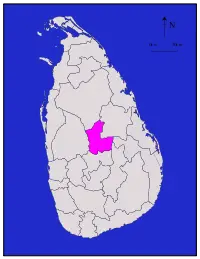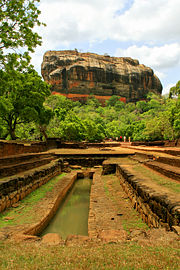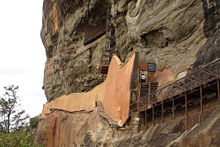Sigiriya
Coordinates:
| Ancient City of Sigiriya* | |
|---|---|
| UNESCO World Heritage Site | |
| State Party | |
| Type | Cultural |
| Criteria | ii, iii, iv |
| Reference | 202 |
| Region** | Asia-Pacific |
| Inscription history | |
| Inscription | 1982  (6th Session) |
| * Name as inscribed on World Heritage List. ** Region as classified by UNESCO. | |
Sigiriya (Lion's rock) is a rock fortress and ruins of a palace situated in central Matale District of Sri Lanka dating to the fifth century B.C.E. Although the history of the building of the fortress, palace, and monastery is unclear, most probably it was built by King Kasyapa (477‚Äď495 C.E.) of the Moriyan dynasty as a fortress and palace. After Kasyapa's death, the fortress was converted into a Buddhist monastery and served for the next eight hundred years when it was abandoned in the fourteenth century. Rediscovered by British explorer John Still in 1907, the site has undergone extensive archeological work, opened to researchers, scholars, and visitors.
Located on a prominent hill standing 370 m above the plane surrounding it, Sigiriya makes a striking appearance. The site has tremendous cultural and historical significance. Its western rock face, 140 m long and 40 m high, has won acclaim for the abundant erotic frescoes that are strikingly similar to the paintings in Ajanta Caves of India. Sigiriya has an upper palace that sits at the top of the rock, a mid level terrace, a lower palace with gardens, moats, and walls at the base of the rock. The architects created a sophisticated reservoir and garden system for aesthetic beauty, drinking water, and air cooling. When Sigiriya converted to a monastery after King Kasyapa's death, Buddhist monks removed many of the erotic paintings as out of keeping for a place of religious practice. UNESCO designated Sigiriya a World Heritage Site in 1982, one of seven World Heritage sites in Sri Lanka.
History
Sigiriya, inhabited from prehistoric times, has been used as a rock-shelter mountain monastery from about the fifth century C.E. King Kashyapa built the garden and palace. Following Kasyapa's death, the site again became a monastery complex until abandoned in the fourteenth century.
British explorer John Still rediscovered the ruins in 1907. Archaeologist Senarath Paranavithana deciphered the Sigiri inscriptions, publishing an authoritative two volume work, "Sigiri Graffiti."[1] He also wrote the popular book "Story of Sigiriya."[2]
Mahavansa, the ancient historical record of Sri Lanka, describes King Kasyapa as the son of King Dhatusena. Kasyapa murdered his father by walling him alive into a room, proceeding to usurp the throne from to his brother Mogallana, the rightful heir to the throne. Mogallana, fleing to India to escape assassinating by Kasyapa, vowed revenge. He raised an army in India, intending to return and reclaim the throne of Sri Lanka. Planning for Mogallana's return with an army, Kasyapa built his palace on the summit of Sigiriya as a fortress.
Mogallana attacked with his army. Chronicles relate that Kasyapa's battle-elephant changed direction to get a better fighting position, but the army misinterpreted it as the king fleeing. His armies abandoning him, Kasyapa committed suicide by falling on his sword. Moggallana returned the capital to Anuradapura and turned Sigiriya into a monastery complex.
Kasyapa's actual fate has been difficult to ascertain. One version relates that a concubine assassinated him with poison. Another has him cutting his own throat when faced with inevitable capture during his final battle.[3]
Several versions of the building of Sigiriya exist. In one account, King Dhatusena had been the ruler to begin building Sigiriya, with Kasyapa finishing the work in honor of his father. Still another account portrays Kasyapa as a playboy king, with Sigiriya a pleasure palace. In another account, the site had been created by a Buddhist community, with no military function at all. All in all, the historical background for Sigiriya has been difficult to unravel.
Archaeological remains and features
Sigiriya rock, a hardened magma plug from an extinct and long-eroded volcano, stands high above a surrounding plain visible for miles in all directions. The rock, resting on a steep mound, rises 370 meters. With sheer wall on all sides, the rock overhangs its base in many places.[4]
Sigiriya, consisting of the remains of an ancient castle built by King Kasyapa during the fifth century C.E. The remains include:
- An upper palace siting on the flat top of the rock. The upper palace includes cisterns cut into the rock that still retain water.
- A mid-level terrace that includes the Lion Gate and the mirror wall with its frescoes
- The lower palace that clings to the slopes below the rock
- The moats, walls and gardens that extend for some hundreds of meters out from the base of the rock. They have retained much of their original exquisite beautiful.[5]
The site most likely served as both a palace and fortress. Reasonably well preserved, Sigiriya provides the visitor with a stunning insight into the ingenuity and creativity of its builders.
Site plan
Archaeologists consider Sigiriya one of the most important urban sites of the first millennium, revealing an elaborate and imaginative city plan. The architects interlocked the symmetry of the fort with the natural surroundings. On the west side of the rock, the designers placed a royal park. Some of reservoirs, including sophisticated underground channels, still function. The south side reveals a man made reservoir of the type used extensively in dry zones of ancient Sri Lanka. Five gates mark entrances to the city, the more elaborate western gate most likely reserved for royalty.[6]
The Gardens
The landscaped gardens of the Sigiriya city, considered one of the most important aspects of the site, stand among the oldest in the world. The architects created three types of gardens: Water, cave and stone. The water gardens, with pools of various depths, has streams flowing over slabs of marble. Underground channels, which still operate, provide water to the fountains. Other water gardens use channels to cool the pavilions. Stone gardens integrate pathways with pavilions and ponds.
The Mirror Wall
Originally the wall had been so well polished that the king could see himself while walking alongside it. Made of porcelain, the mirror wall contains verses scribbled by visitors to the rock dating from the eighth century. People from all walks of life wrote on the mirror wall, reflecting on subjects like love, irony, and every day experiences. The Sri Lanka government has prohibited further writing on the Mirror Wall.
Frescos
The paintings originally covered most of the western face of the rock, an area 140 meters long and 40 meters high. Some of the graffiti on Mirror Wall refers to those paintings which depict 500 ladies. Many of them have been images of women have been destroyed, removed when the Palace reconverted to a Monastery so that they would not disturb meditation.
The paintings, dated to the Anuradhapura period, possess a unique painting style, the line and style differing from typical Anuradhapura paintings. The lines have been painted in a form which enhances the sense of fullness of figures. The paint has been applied in sweeping action strokes using more pressure on one side giving the effect of a deeper color tone towards the edge. Other paintings of the Anuradhapura period contain similar painting techniques. But they lack the sketchy nature of the Sigiriya drawings, as the painting of the Anuradhapura period uses a technique of drawing distinct lines.
Gallery
Outer Gardens and Moat
Gardens
Lower Palace
Mirror Wall and Lion Gate
Paintings (Frescos)
Top of the Rock
See also
Notes
- ‚ÜĎ Ceylon Archaeological Dept. and Senarat Paranavitana, Sigiri Graffiti; Being Sinhalese Verses of the Eighth, Ninth, and Tenth Centuries (London: Published for the Govt. of Ceylon by Oxford University Press, 1956, OCLC 889931).
- ‚ÜĎ Sri Lanka Library, The Story of Sigiriya: WWW Virtual Library Sri Lanka. Retrieved September 7, 2008.
- ‚ÜĎ UNESCO, The Sigiriya Story. Retrieved December 15, 2008.
- ‚ÜĎ Encyclop√¶dia Britannica, Sigiriya. Retrieved January 18, 2008.
- ‚ÜĎ Epoch Times, Sri Lanka: Slip Into Antiquity. Retrieved May 4, 2005.
- ‚ÜĎ Sunday Observer, Sigiriya‚ÄĒthe Fortress in the Sky.
ReferencesISBN links support NWE through referral fees
- Bandaranayake, Senake. 1999. Sigiriya: City, Palace, and Royal Gardens. Colombo: Central Cultural Fund, Ministry of Cultural Affairs. ISBN 9789556131116.
- Bopearachchi, Osmund. 2006. The Pleasure Gardens of Sigiriya: A New Approach. Colombo: Godage Book Emporium. ISBN 9789552096419.
- Ceylon Archaeological Dept., and Senarat Paranavitana. 1956. Sigiri Graffiti; Being Sinhalese Verses of the Eighth, Ninth, and Tenth Centuries. London: Published for the Govt. of Ceylon by Oxford University Press. OCLC 889931.
- De Silva, R. H. 2004. Archaeological Guide to Sigiriya. Colombo: Bibliotheque (Pvt.) Ltd. ISBN 9789558655023.
- De Silva, R. H. 1971. Sigiriya. Colombo: Dept. of Archaeology. OCLC 572596.
- De Silva, R. H. 2002. Sigiriya and its Significance: A Mahayana-Theravada Buddhist Monastery. Nawala: Bibliotheque. ISBN 9789558655016.
- LokubaŠĻኳćńĀra, Vi. Ja. Mu, and Patrick Ratnayake. 2007. The Mystique of Sńęgiriya: Whispers of the Mirror Wall. Colombo: Godage International Publishers. ISBN 9789553006103.
- Murphy, Richard. 1989. The Mirror Wall. Winston-Salem, N.C. USA: Wake Forest University Press. ISBN 9780916390365.
- Paranavitana, Senarat. 1972. ńÄnanda-shtavira. OCLC 164946751.
External links
All links retrieved January 29, 2023.
- Official UNESCO website entry.
- Sigiriya, the 'Mount of Remembrance'.
- Video: Digital recreation of what Sigiriya may have looked like.
- Sigiriya photos in FOTOSEARCH.com.
- The Story of Sigiriya.
- Sigiriya Narratives.
- The Citadel City.
- Sigiriya The palace and fortress in the sky.
| |||||||
Credits
New World Encyclopedia writers and editors rewrote and completed the Wikipedia article in accordance with New World Encyclopedia standards. This article abides by terms of the Creative Commons CC-by-sa 3.0 License (CC-by-sa), which may be used and disseminated with proper attribution. Credit is due under the terms of this license that can reference both the New World Encyclopedia contributors and the selfless volunteer contributors of the Wikimedia Foundation. To cite this article click here for a list of acceptable citing formats.The history of earlier contributions by wikipedians is accessible to researchers here:
The history of this article since it was imported to New World Encyclopedia:
Note: Some restrictions may apply to use of individual images which are separately licensed.















